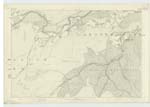OS1/1/9/34
| List of names as written | Various modes of spelling | Authorities for spelling | Situation | Description remarks |
|---|---|---|---|---|
| BIG STANE 0' CARN BEAG | Big Stane o' Carn Beag Rocking Stone |
Mr. William Ingram Senr. [Senior](Etnach) Mr. William Ingram Junr [Junior] (Etnach) |
092 | This object is situated on the East side of the Pollagach Burn and about a mile and a half South of Ballaterach farm house. The "Rocking Stone", which rests on a natural piece of rock on the top of a ravine about 200 feet above the bed of the Burn is a rough Elliptical spheroid, (or rather, "Egg-shaped",) about 12 feet, in length through major axis and 9 feet through Minor axis, and is supposed to weigh about 20 Tons. The point of oscillation rests on a flat rock, and when seen from below the Stone appears to be so weakly supported that it would impress a passer-by with a sense of danger.- The Rocking Stone is known in the district by the name of "Big Stane o' Carn Beag".- |
| ROCKING STONE [Big Stane o' CaRn Beag] | 092 | The "Rocking Stone", which rests on a natural piece of rock on the top of a ravine about 200 feet above the bed of the Burn is a rough Elliptical spheroid, (or rather, "Egg-shaped",) about 12 feet, in length through major axis and 9 feet through Minor axis, and is supposed to weigh about 20 Tons. The point of oscillation rests on a flat rock, and when seen from below the Stone appears to be so weakly supported that it would impress a passer-by with a sense of danger.- The Rocking Stone is known in the district by the name of "Big Stane o' Carn Beag". |
Continued entries/extra info
[Page] 34"Stane - Stone". (Jamieson)
"Carn - A heap or pile of Stones, raised over the tombs of heroes."
"Beag - Little, small, etc."- (Gaelic)
Literally - Large stone of the Little Cairn.
"Among the vast variety of Druid Monuments in North Britain, one of the most interesting is the Rocking Stone, which
seems to have existed, in every country and every period. That those singular Stones are Druid remains Cannot be
easily doubted, by the scepticism, which denies the evidence of Druid remains in North Britain. It was, after the sublime truths
of Druidism, had fallen into the grossness of superstition, and the pure adoration of the Deity had degenerated into delusive imposition, that
the Rocking Stones, whether natural, or artificial, were brought in, either to induce belief, or to heighten devotion. And these rocking Stones
are still to be seen, the objects of learned Curiosity, but of ignorant wonder, in every district of North Bitain, as well as in Cornwall and in Wales".
(Chalmer's Caledonia Page 76.)
Transcribers who have contributed to this page.
Kate51- Moderator, Jane F Jamieson, pungo
Location information for this page.
Linked mapsheets.




